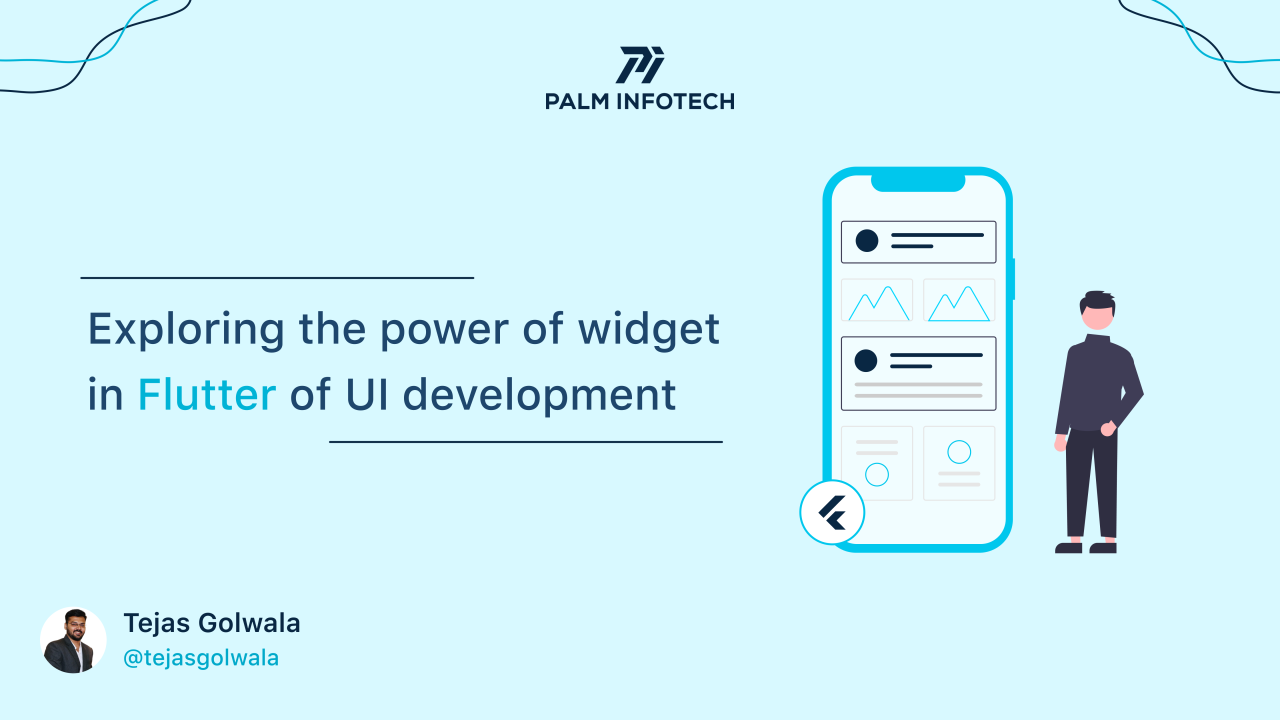
Exploring the Power of Widgets in Flutter for UI Development
Tejas Golwala
?? CEO @ Palm Infotech | ?? Mobile App Solutions | ?? Expert in Swift, Kotlin, React Native, Flutter | ?? Agile Enthusiast | ?? 13+ Years Industry Experience | ?? Innovator in Tech Solutions
Widgets are the fundamental building blocks in Flutter for creating the UI. Every element you see in a Flutter app, including text, buttons, images, and layouts, is a widget. They define the visual structure, how the elements behave, and how they interact with each other. Flutter uses a widget tree structure, where widgets can be nested within other widgets to build complex UIs.
Key Points:
Everything in Flutter is a widget.
Widgets form the core of how UI is built in Flutter.
2. Types of Widgets
Stateless Widget: These widgets don't change after they are built. They render once and remain static. For example, a Text widget displaying a label doesn't change unless the widget is rebuilt.
Stateful Widget: These can change over time. For instance, a button whose color changes when pressed would be a stateful widget. These widgets maintain a mutable state and can trigger rebuilds when the state changes.
Container: A versatile widget used for layout and styling. It can contain other widgets and allows for padding, margin, and alignment.
Text: Used to display simple text. You can apply styles such as font, size, and color.
Image: Used to display images from assets, network, or memory.
Row/Column: Arrange children in a horizontal (Row) or vertical (Column) direction.
Stack: Allows you to layer widgets on top of each other.
List View: Displays a scrollable list of widgets.
Grid View: Displays items in a grid format.
Expanded/Flexible: Helps distribute space among widgets inside a Row or Column.
3. Widget Composition
This refers to building complex UIs by combining simple widgets. Flutter’s power comes from being able to nest widgets and create an entire UI using hierarchical widget trees. A complex UI element like a card with an image, text, and buttons can be composed of smaller widgets like Container, Image, Text, and Button.
Key Points:
Widget composition is a way to break down complex UIs into smaller reusable pieces.
This promotes cleaner code and better UI organization.
4. Custom Widgets
While Flutter provides a large number of built-in widgets, creating custom widgets is important for better reusability and maintainability. Custom widgets allow you to define reusable UI components with specific behaviors or layouts. For example, you can build a custom button with a particular style that can be reused across your app.
Key Points:
Custom widgets simplify complex UIs.
Helps in maintaining a consistent UI throughout the app.
5. State Management
State management refers to how data (state) is maintained and shared across widgets. Since Flutter widgets are immutable, when data changes, the widget tree needs to rebuild with the new state.
Methods of State Management:
setState(): The simplest way to manage state in a StatefulWidget.
领英推荐
InheritedWidget: Used to propagate state across the widget tree.
Provider: A popular library that abstracts InheritedWidget and simplifies state management across large apps.
6. Responsive Design with Widgets
Flutter provides several widgets to help build UIs that adapt to different screen sizes, orientations, and platforms. This is especially useful for designing apps that work across various devices, from phones to tablets.
Key Widgets/Tools:
Media Query: Allows you to query screen size, orientation, and platform.
Layout Builder: Helps build responsive UIs by providing constraints on the available space.
Flexible and Expanded widgets: Adjust layout to use available space dynamically.
7. Performance Considerations
Flutter’s widget system is efficient, but improper use of widgets can cause performance bottlenecks. Optimizing performance ensures that your app remains fast and responsive.
Techniques:
Avoiding unnecessary rebuilds: Using const constructors or Keys to prevent frequent widget rebuilding.
Reusing widgets: Rather than creating new widgets in every build, reuse existing widgets to improve performance.
Use of Widgets like ListView.builder: For large lists, ListView.builder ensures efficient memory use by lazily building only visible items.
8. Interactivity and Gesture Handling
Flutter provides a variety of interactive widgets such as buttons, sliders, and switches. It also supports more complex gestures like swiping and dragging, which can be detected using widgets like Gesture Detector.
Interactive Widgets:
Button Widgets: Elevated Button, Text Button, Icon Button.
Gesture Detector: Detects taps, drags, swipes, and other gestures.
Form Widgets: Input fields like Text Field, Checkbox, and Radio Button for user input.
9. Animations with Widgets
Animations enhance the user experience by adding smooth transitions and effects. Flutter makes it easy to create animations using built-in animated widgets or the powerful Animation Controller.
Common Animation Widgets:
Animated Container: Transitions properties like size, color, or alignment smoothly over time.
Fade Transition, Slide Transition: Built-in widgets for specific transition effects.
Tween Animation Builder: Allows you to animate between values using a Tween object.
10. Theming and Styling Widgets
Flutter allows you to easily customize the look and feel of your app using themes. You can apply styles globally (using a Theme Data) or to specific widgets using properties like Text Style, Box Decoration, etc.
Theming:
Theme Data: Defines the overall visual style of the app.
Custom Styles: Widgets like Text or Container allow applying custom styles for fonts, colors, and borders.
In Flutter, widgets are a core concept that enables the creation of dynamic, responsive, and customizable user interfaces. From basic widgets to animations, state management, and performance optimizations, Flutter provides a wide array of tools that allow developers to build rich UIs efficiently. Understanding the power of widgets allows developers to harness the full potential of Flutter for UI development.
#UIDevelopment#MobileAppDevelopment#StatelessWidget#StatefulWid#FlutterUI#ResponsiveDesign#FlutterDevelopment#FlutterWidgets